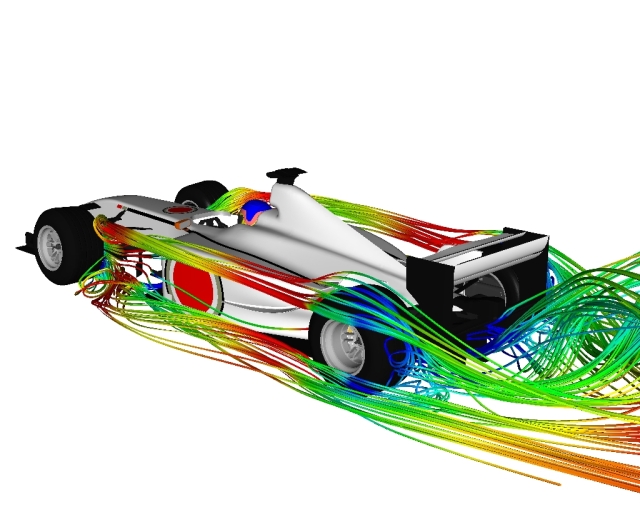
The End of Clusters?
Are we approaching the end of cluster computing for Computer-Aided Engineering (CAE) analysis tools such as Computational Fluid Dynamics (CFD)? Or is it simply the end of the beginning of an era to be further dominated by clusters?
 Formula 1 (RANS) CFD Simulation: Performed by Advantage CFD on a clusterSymscape does not hold the copyright on this picture
Formula 1 (RANS) CFD Simulation: Performed by Advantage CFD on a clusterSymscape does not hold the copyright on this picture
A cluster is a collection of discrete computers typically linked together by a fast local area network (LAN). The premise is that a collection of computers can process data in parallel much faster and more cost effectively than a single standalone computer. Until recently clusters were the only viable means to compute large CFD simulations for engineering applications, such as those found in Formula 1. To perform a CFD simulation using a cluster incurs considerable costs in terms of:
- Multiple computers
- Fast networking equipment
- Configuring multiple computers with operating systems and analysis software
- Data center to house and cool computing equipment
- IT specialists to maintain the cluster
Clearly clusters are out of the reach of most small businesses and hobbyists. Don't despair however; the relentless pace of Moore's Law has seen the benefits of clusters migrate into single machines. Now we have available 64-bit computers that are able to address massive memory arrays, which can easily handle most engineering analysis simulations in terms of size. Multi-core and multi-processors mean that the same parallel speed-up that a cluster provides is now available within the confines of a single PC. Also a single machine doesn't suffer from the lag associated with clusters using a network to communicate. Innovations within the graphics card industry have provided Graphics Processing Units (GPUs) that can run massively parallel simulations faster than traditional CPUs. All this can be yours within the confines of a well configured but modestly priced desktop or laptop PC.
In addition to the ever increasing performance/price ratio of PCs, CAE analysis tools, such as Caedium, are now also within the range of these same small businesses and hobbyists in terms of ease-of-use and affordability. This isn't to say that clusters are redundant. There will always be a need to perform huge simulations in a timely manner. For example, Large Eddy Simulation (LES) and even more so Direct Numerical Simulation (DNS) for fluid flow simulation require huge computing resources which can keep the fastest clusters busy for weeks on end. However, many engineering applications, well served by current Reynolds Averaged Navier-Stokes (RANS) simulations, could easily be analyzed on a well configured desktop or laptop PC in the not-too-distant future.
- Richard Smith's blog
- Login to post comments
Select Language
Recent blog posts
- CFD Simulates Distant Past
- Background on the Caedium v6.0 Release
- Long-Necked Dinosaurs Succumb To CFD
- CFD Provides Insight Into Mystery Fossils
- Wind Turbine Design According to Insects
- Runners Discover Drafting
- Wind Tunnel and CFD Reveal Best Cycling Tuck
- Active Aerodynamics on the Lamborghini Huracán Performante
- Fluidic Logic
- Stonehenge Vortex Revealed as April Fools' Day Distortion Field


Comments
which is better for high
which is better for high performance computing...
1. 4 node single core single processor cluster
2. 4 core single processor workstation
3. dual core 2 processor workstation
with same processor performance...
Parallel CFD simulations using MPI
For parallel CFD simulations using MPI you will likely see the best performance on a single workstation (no network latency) with a dual core 2 processor system (assuming individual caches per processor). This assumes that the case partitioning and size are optimal.
For big cases the optimal partitioning will likely require more processes (e.g., 20), where a cluster would be the best alternative.
Then of course there is the reality of what computer setup can you afford or do you already have? It's always a compromise.